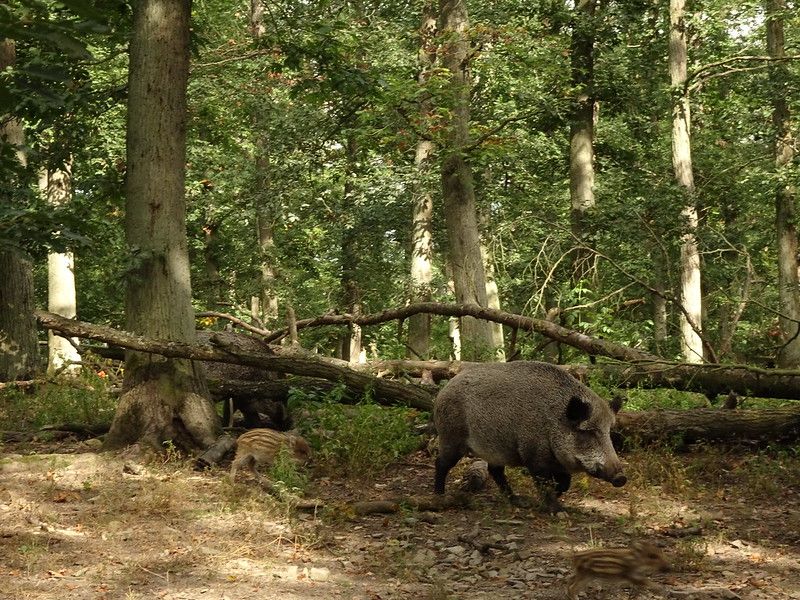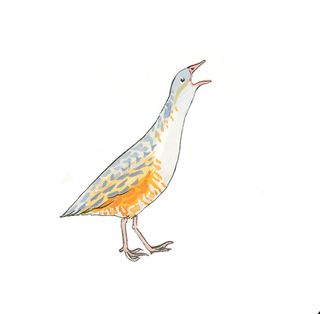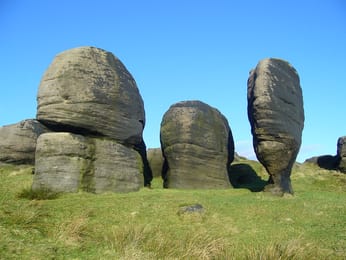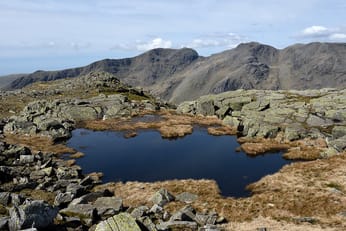
Hottest Year & Curlew Conservation
The latest news on nature and conservation in Britain.
National news
2022 | The Met Office has confirmed that last year was the hottest year on record for the UK, with an average temperature of over 10°C recorded for the first time. In an attribution study, Met Office scientists used climate models to compare the likelihood of a 10°C annual temperature average with and without human-induced climate change. They found that this event would occur around once every 500 years in an unaltered climate, whereas in the current climate it could be as frequent as every three or four years. Dr Mark McCarthy of the Met Office said: “Although an arbitrary number, the UK surpassing an annual average temperature of 10°C is a notable moment in our climatological history.” Wildlife struggled during a year of weather extremes: the Times reports on how nature was affected, while the Wildlife Trusts’ review warns that new discoveries were undermined by growing threats to marine life. The Guardian’s environmental review of 2022 dubbed record emissions as “another mile on the highway to climate hell”. But not all news from last year was depressing. The Natural History Museum highlighted twenty conservation success stories from the year, while the Times and the Guardian both wrote about the hundreds of new species discovered. ENDS wrapped up the environmental stories you might have missed over Christmas.
Farming | Defra has announced that farmers will receive increased payments for protecting nature and producing food sustainably under the new Environmental Land Management schemes. In a speech to the Oxford Farming Conference, farming minister Mark Spencer announced the additional money, saying that it would “ensure farmers are not out of pocket for doing the right thing by the environment.” The changes mean farmers could earn an additional £1,000 per year under the Sustainable Farming Incentive. However, the NFU warned that the increased payments could be “too little too late” amid the rising cost of food production, while the Wildlife Trusts said the announcement revealed a “desperately low ambition” for the schemes. The Guardian has also revealed that uptake has been slow so far, with only 224 farmers paid under the post-Brexit schemes last year. The BBC, the Guardian, the Telegraph, the Financial Times and the Independent covered the news.
Governance | On Wednesday, Rishi Sunak delivered a speech designed to soothe public “apprehension” about life in the UK – which he did not appear to think included the environment. Topics included the cost of living crisis, healthcare and schools, yet climate change and environment were conspicuously absent. Sunak justified the topics in the speech by claiming they were “the people’s priorities” but not “the limit of [his] ambition for our country”. Edie reported the news, along with an article on the critical green policy gaps Sunak’s government should close in 2023. Meanwhile, Scotland’s biodiversity minister Lorna Slater wrote in the Edinburgh News about why 2023 should be a year of nature restoration.
Not a single mention of climate or nature in Rishi Sunak's speech.
— Greenpeace UK (@GreenpeaceUK) January 4, 2023
The climate crisis is one of the biggest threats our society faces - how can the PM fail to mention it?
In other news:
- Geologists are voting on the site they believe most accurately represents the start of the ‘Anthropocene’, a proposed new geological epoch defined by humanity’s impact on the planet. The Times and the Guardian covered the news.
- Environmental organisation Friends of the Earth is launching legal action against the government over its decision to approve a new coal mine in Whitehaven, reports the BBC. In other news, the UN’s newly appointed climate chief, Simon Stiell, issued a “thinly veiled” criticism of the government’s decision to approve the coal mine, according to the Times.
- NatureScot figures reveal that wind turbines are a significant threat to Scottish birds of prey, reports the Herald. There are also concerns for herring gulls amid bird flu, with the species topping the death count of 37 species, reports the Press and Journal.
Across the country
Yorkshire | Could Christmas trees help stem winter flooding? One enterprising Yorkshire local believes so. In the spring of 2020, Sara Tomkins planted around 400 fir trees in the field behind her house. Every year, she rents out the trees in pots to be used as Christmas trees. When they grow too big for homes, they are “retired” and replanted along the Calder Valley as part of a natural flood prevention scheme minimising storm water surges. This has the dual benefit of reducing the number of trees cut down for the festive season, as well as providing a nature-based solution to the rising threat of flooding in extreme weather. Tomkins said: “It sort of feels perfect that Christmas trees that would otherwise be cut down can help.” The Times reported the story.
Kinross | The Scottish Greens are calling for Loch Leven to become Scotland’s first protected wild swimming hotspot. The loch is the largest natural body of water in the UK, and home to more freshwater breeding ducks than anywhere else in inland Europe. During the pandemic, the loch and its surrounds became a hotspot for wild swimmers and people wanting to spend time outdoors. Mark Ruskell, an MSP for the Mid Scotland and Fife region, said the loch is “one of Scotland’s national treasures”, and that protection as a designated bathing area could spark action to combat pollution and water quality issues, such as the spread of toxic algal blooms. NatureScot, which monitors the loch as a national nature reserve, said it was taking expert advice on actions to prevent excess phosphorus from entering the loch. The Scotsman and the Herald reported the story.

Derbyshire | Health professionals in England will now be able to prescribe time in nature after a successful pilot in Scotland. The trial project in Derbyshire will be led by the RSPB and the Peak District National Park Authority. The prescriptions are based on accessible activities, such as listening to birdsong, which aim to help people connect with nature and boost their health and wellbeing. Over 74% of patients in the Scottish trial said they had benefited from the prescriptions, and the project is now expanding to more locations in Scotland as well. The BBC reported the news.
Elsewhere:
- Scarborough Council cancelled the town’s New Year’s Eve fireworks display so as not to disturb Thor, an Arctic walrus who was resting in the harbour. The Guardian and the Hull Daily Mail covered the news.
- Gateshead Council has given planning permission for a newly designed nesting tower to be built for the River Tyne kittiwakes, reports BirdGuides. Elsewhere, kittiwake nests have been removed from Spa Bridge in Scarborough, reports the BBC.
- Urban streams in London are acting as “open sewers”, reports the Times. Meanwhile, sewage discharges into a Hampshire chalk stream is an “environmental disaster”, reports the Daily Echo.
- The RSPB has launched a woodland restoration scheme in the north of the New Forest, using cattle to graze the woodland, reports BirdGuides.
- Local residents are calling for a halt to the industrialisation of “top quality farmland” in North Yorkshire, reports the Yorkshire Post.
- A bereaved beaver in the Forest of Dean has been given a new mate, reports the BBC. Meanwhile, a pair of beavers reintroduced to Nottinghamshire has produced kits, reports BirdGuides.
- Pelaw Wood in Durham City has been designated a local nature reserve to protect it from future development, reports the Northern Echo.
- The use of antibiotics by the salmon farming industry in Scotland has soared in the last four years, despite reductions in other industries, reports the Herald.
- A project led by Natural Resources Wales is recruiting volunteers to identify sharks, rays and skates captured by underwater cameras along the Welsh coast, reports the BBC.
- Aberdeen is trialling eco-friendly grass-topped bus stops to boost urban biodiversity and insect numbers, reports the Press and Journal.
- The Mammal Society is calling on the public to report sightings of the non-native Greater White-toothed Shrew after a sighting in Sunderland, reports BirdGuides.
- Overnight camping in motorhomes and campervans has been banned at an Isle of Man nature reserve after they caused damage to dune grassland turf, reports the BBC.
- NatureScot has confirmed that at least seventeen little tern chicks fledged at an Aberdeenshire reserve last summer, despite fears around bird flu, reports BirdGuides.
- Derbyshire Dales District Council, which was criticised by Chris Packham for mowing wildflowers, has expanded its biodiversity scheme, reports BirdGuides.
- The public have been asked to steer clear of hundreds of seals which have arrived on a beach in Llandudno, in north Wales, reports the BBC.
- Lancaster University is setting up the UK’s first laboratory researching the effects of light pollution, reports the BBC.
- A rewilding project in the Highlands has reached its £50,000 crowdfunding target in just one month, reports the Press and Journal.
- National Trust Cymru is creating a “hedgerow super-highway” in the Foel landscape of north Wales, reports Cambrian News.
- A project is hoping to reintroduce seagrass meadows to the Tees for the first time in over a century, reports Gazette Live.
Reports
Dairy | A report by the Food Ethics Council explores how dairy could be produced in a fairer and more ethical way. At a time of soaring input costs, many dairy producers have had to choose volume over quality, with knock-on effects for animal welfare, farm worker health and the environment, according to the council. They interviewed 40 farmers and farm workers to hear their aspirations for change as well as perceived barriers. The report found a “real appetite for positive change”. The long list of barriers, however, included lack of clarity on government subsidies, lack of access for new entrants, and risks of supply for more ‘natural’ dairy systems. The council will use the report as context for the next phrase of their Dairy Project, when they engage with other stakeholders across the dairy chain to begin unblocking some of the barriers to a fairer system.
Bumblebees | The 2022 BeeWalk report by the Bumblebee Conservation Trust reviews the past decade of the project. BeeWalk is a UK-wide monitoring scheme which invites volunteers to walk a fixed route monthly between March and October, counting the bumblebees they see and identifying them. The report summarises ten years of citizen science from 2011 to 2021. Over the decade, bumblebee abundance increased year-on-year from 2011 to 2016, with mixed fortunes from 2017 to 2021. These years included a sharp decline in 2018, likely due to the summer heatwave, and another drop in 2021 due to the cold spring. The BeeWalk dataset is now one of the largest bumblebee datasets in the world, and is integral to monitoring long-term population changes.
Squirrels | Actions to protect native red squirrels from non-native greys need rethinking, according to a research report by Forestry and Land Scotland, the University of Highlands and Islands, and Heriot-Watt University. Currently, timber forests in Scotland with populations of red squirrels are required to follow special measures such as avoiding felling trees during breeding season and removing types of broadleaf trees preferred by grey squirrels. However, the research revealed that many of these measures take place in areas without grey squirrels present. The study estimated as much as £100,000 per year may be wasted on actions where there is no threat. The authors conclude that red squirrel-specific management should be reviewed. The research was published last summer, but was covered by the Scotsman and the Telegraph this week following a university press release.
Science
Curlews | Landscape-scale action is needed to boost the security of curlew nests, according to a paper in the International Journal of Avian Science. Eurasian curlews are a red-listed species in the UK, largely due to rapid declines in breeding numbers. To explore how conservation actions could boost breeding success, researchers monitored 80 curlew pairs between 2019 and 2021 in eight locations across Breckland in Norfolk. They found that the majority of breeding failure was caused by predation at night. The authors conclude that fencing the sites with high nesting densities could potentially double the number of chicks each year, but landscape-scale actions to reduce predator impacts are needed to improve breeding numbers in the wider countryside. Author and birdwatcher Graham Appleton wrote up the research on his blog, Wader Tales.
Farming | A study in People and Nature has found that setting aside agricultural land for nature is a cost-efficient way to meet environmental targets, while still delivering on food production. Researchers compared the cost of “land sharing” – trying to farm in a nature-friendly way – with “land sparing”, where large areas are removed from production altogether. They found that land sparing delivered biodiversity and carbon emission targets at 79% of the food production cost and 48% of the taxpayer cost of land sharing. The authors suggest that the financial merits of land sparing would increase even further in studies that incorporated factors such as the species and ecosystem services not deliverable on farmland. They conclude that the findings of the study should inform a rethink of England’s new Environmental Land Management scheme. FarmingUK covered the research. Separately, a paper in the Journal of Applied Ecology by RSPB researchers found that farmland bird populations increase when farms devote at least 10% of their land to nature-friendly farming practices.
Carbon | British forests could be storing twice as much carbon as previously thought, according to a paper in Ecological Solutions and Evidence. The study also found that mature woodlands are particularly important as carbon sinks. Researchers used lasers to scan 815 trees in Wytham Woods in Oxfordshire, one of the most studied forests in the world. By measuring the volume of the trees, they were able to calculate the amount of carbon stored in each trunk, and found it to be 77% higher than previous estimates. This model could help inform decisions about how to manage woodland across the UK, as well as highlighting the environmental cost of losing it – especially ancient and veteran trees. The BBC covered the research.
Driftwood
Peatbog | This BBC article explores why Scotland’s Flow Country, the most extensive and intact blanket bog system in the world, has been nominated for special status as a UNESCO World Heritage site. The designation would recognise both the ecological and biological processes of the peatbog, as well as its biodiversity: the Flows are home to a diverse range of species including birds, otters and water voles. In places the peat can be up to ten metres thick, and stores an estimated 400 million tonnes of carbon, thus helping to combat climate change. As well as promoting the environmental value of peatland, some locals believe that securing UNESCO status could bring new economic opportunities to the area, in the form of sustainable tourism and produce branding. The formal bid for designation is due early this year with a decision expected in 2024.
Boar | A feature in the Guardian looks at public opinion of wild boars, which are becoming reestablished in Scotland and isolated areas of England after being hunted to extinction. Despite media coverage which suggests that wild boars are “mutant, dangerous, sheep-eating feral pigs”, environmentalists with first-hand experience and knowledge of the animals say there is little truth in these tales. Hugh Raven, an estate manager who lives near boars in the Highlands, said: “The idea of them attacking humans is highly improbable. There needs to be a public information campaign as there is a widespread misapprehension about their behaviours.” Boars are also thriving in the Forest of Dean, where Chantal Lyons, who is writing a book on the species, has found they act as ecosystem engineers. Lyons wrote about her interactions with the much maligned creatures in Inkcap Journal.

Fiction | In the Ecologist, author and editor Nick Hunt explores whether fiction can provide a means to navigate nature loss. He begins by introducing a few of his own creations, metaphorical short stories where he tries to work through what seemed insensible. He then looks at the recent raft of fiction addressing climate and ecological breakdown, from Barbara Kingsolver’s 2012 novel Flight Behaviour to Jessie Greengrass’s recent work The High House. Hunt writes: “At its best, fiction can touch the sides of the gaping hole that ecosystem collapse and extinction leave in my consciousness, briefly giving me a sense of bewildering vertigo.” But narratives are becoming unstable, he argues, and good writers perhaps should no longer fully understand their writing: “Who knows where the story we are telling ourselves will end?”
Further reading:
- The Guardian interviews Professor Claudia Wascher, a researcher in behavioural biology, about the effects of fireworks on wild animals.
- In the Times, a feature explores the work of Bianca Carr to campaign against coastal pollution. Meanwhile, the BBC reports on how citizen scientists are taking it upon themselves to monitor river pollution.
- Gwen Potter, a National Trust countryside manager, writes in the Guardian about her work on the frontlines of the bird flu outbreak in the Farne Islands. Guardian readers also describe their personal experiences of the impact of the disease.
- In Countryfile, journalist John Craven writes about how countryside waste crime has reached new levels.
- A BBC Future article explores the possibility of sustainable batteries made from trees.
- In Smithsonian Magazine, a feature details the science behind dating the oldest trees in the world.
- A blog by the John Muir Trust recounts an “adventure with purpose” by Ailsa Beck and Nellie Wilson, who cycled across Scotland to visit nature regeneration projects.
Happy days
Photography | The Natural History Museum has invited the public to vote for their favourite wildlife image to win this year’s people’s choice award. Judges have picked 25 shortlisted images that highlight the importance of capturing powerful nature stories from around the globe. One image from Bristol features an urban fox eating a chicken leg given to it by local residents. Voting ends on 2nd February. The Guardian covered the story. Also in pictures, the Shropshire Star features a range of photos from the South Downs photography prize – including a winning pair of little owls.
Subscribe to our newsletter
Members receive our premium weekly digest of nature news from across Britain.
Comments
Sign in or become a Inkcap Journal member to join the conversation.
Just enter your email below to get a log in link.








